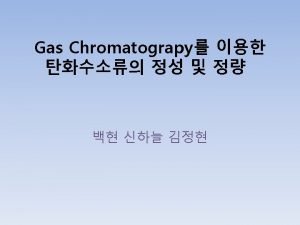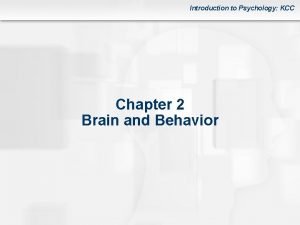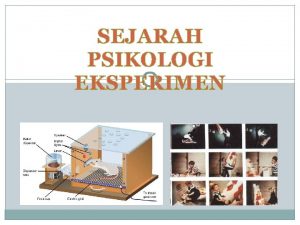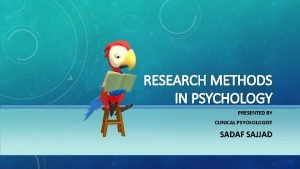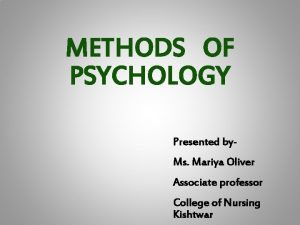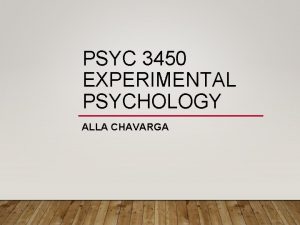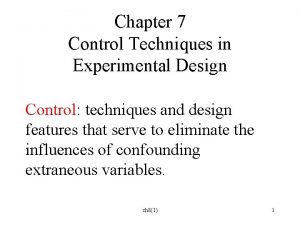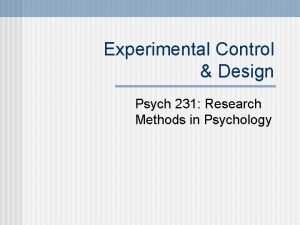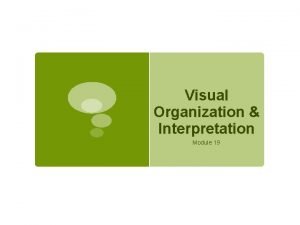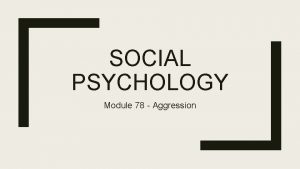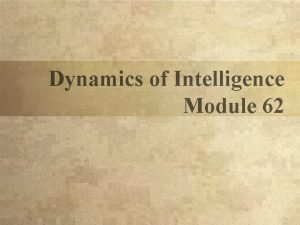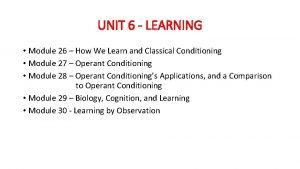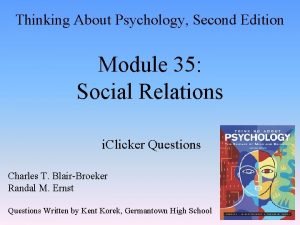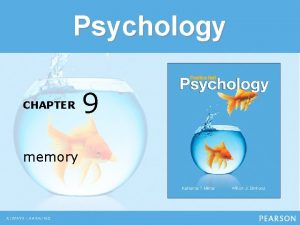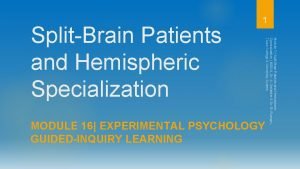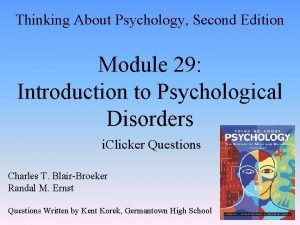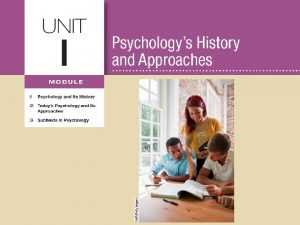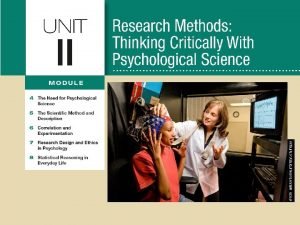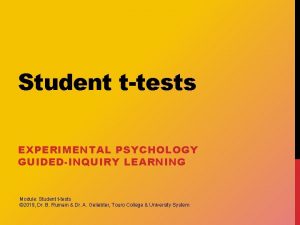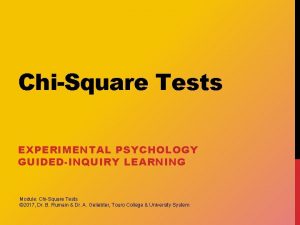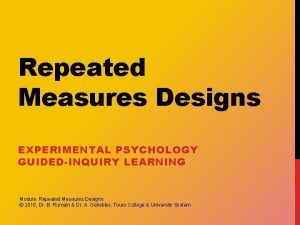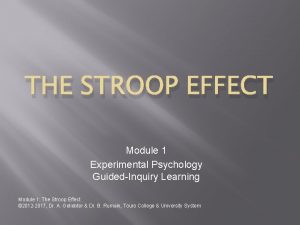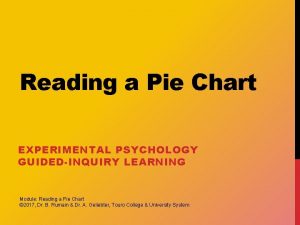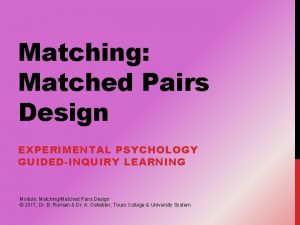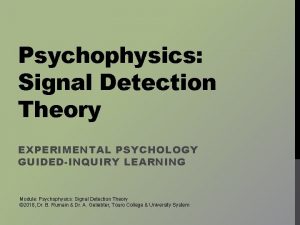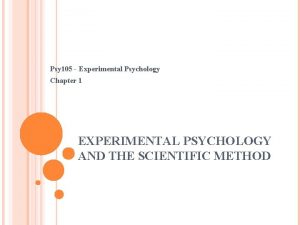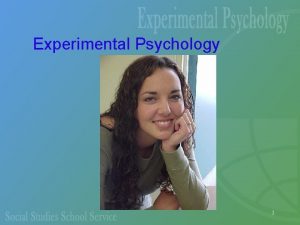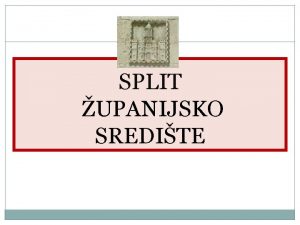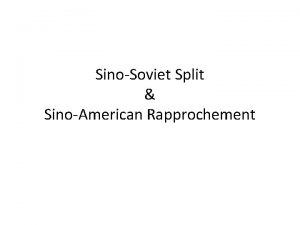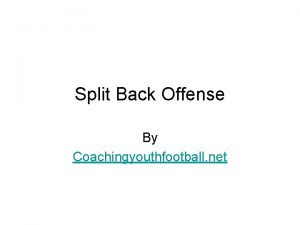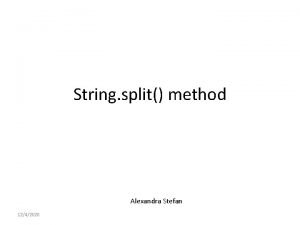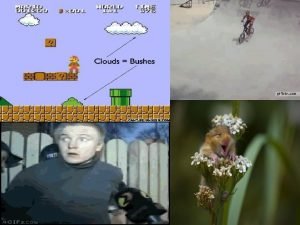MODULE 16 EXPERIMENTAL PSYCHOLOGY GUIDEDINQUIRY LEARNING Module Split

































- Slides: 33

MODULE 16| EXPERIMENTAL PSYCHOLOGY GUIDED-INQUIRY LEARNING Module ? | Split Brain Patients and Hemispheric Specialization | © 2014, Dr. A. Geliebter & Dr. B. Rumain, Touro College & University System Split-Brain Patients and Hemispheric Specialization 1

Motivation Dr. Sperry started his investigations with cats and monkeys and then went on to study humans. He worked with "split-brain" patients very much like Mr. Split Brainy, whom you will meet in the activity below. Module ? | Split Brain Patients and Hemispheric Specialization | © 2014, Dr. A. Geliebter & Dr. B. Rumain, Touro College & University System Dr. Roger Sperry won the Nobel Prize in Physiology and Medicine in 1981. He received this prize for work he carried out in the 1960 s concerning functional specialization of the right and left hemispheres. 2

Motivation In the 1960 s, some people who suffered from a severe special form of epilepsy underwent an operation whereby their corpus callosum was severed. When a person has epilepsy, there is excessive neuronal (nerve cell) activity in the brain. With an intact corpus callosum, this excessive activity of the neurons (nerve cells) can spread from one hemisphere to the other, producing an extensive epileptic seizure. When the corpus callosum is cut, this limits the spread of the electrical activity and confines it to only one hemisphere, thereby reducing the severity of the person's epileptic seizure. Module ? | Split Brain Patients and Hemispheric Specialization | © 2014, Dr. A. Geliebter & Dr. B. Rumain, Touro College & University System The right and left cerebral hemispheres are connected by neuronal bridges called commissures. The largest of these is the corpus callosum. 3

Vocabulary Split-brain patient Cerebral hemispheres: right and left Commissures Neuron Corpus callosum Contralateral Right and left visual field Hemispheric specialization Hemispheric lateralization Module ? | Split Brain Patients and Hemispheric Specialization | © 2014, Dr. A. Geliebter & Dr. B. Rumain, Touro College & University System 4

Information 5 1) The left hemisphere has connections with the right side of the body. Another way of saying this is that the nerve connections are contralateral; namely, the right hemisphere controls the left side of the body whereas the left hemisphere controls the right side of the body. 2) In the visual system, information from the right visual field goes to the left part of each retina and then on to the left hemisphere. Information from the left visual field goes to the right part of each retina and then on to the right hemisphere as seen in the drawing on the left. Module ? | Split Brain Patients and Hemispheric Specialization | © 2014, Dr. A. Geliebter & Dr. B. Rumain, Touro College & University System In the activity below, you will meet "Mr. Split Brainy" who has just had a split-brain operation. You will need to know that:

Activity 6 As you click through The Split Brain Experiment Game, you will be asked to report what you observe and make inferences from your observations. You will then be asked to formulate a hypothesis to explain the results you are observing. Finally, you will need to design another experiment in order to further your hypothesis testing. Start going through the Split Brain Experiment Game. You will meet Mr. Split Brainy. When you get to the section that says "Click on a Slide to Flash It, " answer the following: Module ? | Split Brain Patients and Hemispheric Specialization | © 2014, Dr. A. Geliebter & Dr. B. Rumain, Touro College & University System Click here to “Play the Split Brain Experiments“ developed by Nobelprize. org

7 Module ? | Split Brain Patients and Hemispheric Specialization | © 2014, Dr. A. Geliebter & Dr. B. Rumain, Touro College & University System Question 1: Based on what you see, when an object is flashed in the right visual field, which hemisphere does it go to, the right hemisphere (R. H. ) or the left hemisphere (L. H. )? How does Mr. Split Brainy (SB) respond?

8 Module ? | Split Brain Patients and Hemispheric Specialization | © 2014, Dr. A. Geliebter & Dr. B. Rumain, Touro College & University System Correct answer: When a picture is flashed in the right visual field, it goes to the left hemisphere. (This is in accordance with the diagram above. ) Mr. SB is able to say its name.

9 Module ? | Split Brain Patients and Hemispheric Specialization | © 2014, Dr. A. Geliebter & Dr. B. Rumain, Touro College & University System Question 2: Based on what you see, when an object is flashed in the left visual field, which hemisphere does it go to, the right hemisphere (R. H. ) or the left hemisphere(L. H. )? How does Mr. SB respond?

10 Module ? | Split Brain Patients and Hemispheric Specialization | © 2014, Dr. A. Geliebter & Dr. B. Rumain, Touro College & University System Correct answer: When an object is flashed in the left visual field, it goes to the right hemisphere. Mr. SB reports that he doesn't see anything.

11 Module ? | Split Brain Patients and Hemispheric Specialization | © 2014, Dr. A. Geliebter & Dr. B. Rumain, Touro College & University System Go to the place in the Game where it says, "Have a Coffee Break" and then answer Question#3.

Remember Mr. SR's corpus callosum has been severed, so the two hemispheres can't communicate anymore: the right hemisphere doesn't know what the left hemisphere sees and the felt hemisphere doesn't know what the right hemisphere sees. Each learning team should take its time to share its thoughts and generate some hypotheses. 12 Module ? | Split Brain Patients and Hemispheric Specialization | © 2014, Dr. A. Geliebter & Dr. B. Rumain, Touro College & University System Question 3: Formulate a hypothesis to explain these results, namely, why doesn't the right hemisphere report what it sees when an object is flashed in the left visual field?

Basically, you should come up with the following two possibilities: 1) Something is wrong with Mr. SB's right hemisphere, perhaps as a result of the surgery. He has suffered some injury to his right hemisphere during the split brain operation and doesn't know what is in the left visual field. 2) Mr. SB knows what he saw but he just can't name it because the left hemisphere is the language center, not the right hemisphere. 13 Module ? | Split Brain Patients and Hemispheric Specialization | © 2014, Dr. A. Geliebter & Dr. B. Rumain, Touro College & University System What hypotheses have you formulated?

Do the scientists obtain the grant? go back in the Game to where it says "Have a Coffee Break" and note how the two scientists talk about the results. Correct any mistakes in the scientists' report before they submit their grant proposal to further study Mr. SB. After you finish correcting the report, continue with the Game to see if the scientists obtain the grant. Module ? | Split Brain Patients and Hemispheric Specialization | © 2014, Dr. A. Geliebter & Dr. B. Rumain, Touro College & University System Now, 14

They do obtain the grant! go up to the point where it says "Continue Experimenting" Then have them do Question #4 (on the next slide) which asks them to design the experiment. Module ? | Split Brain Patients and Hemispheric Specialization | © 2014, Dr. A. Geliebter & Dr. B. Rumain, Touro College & University System Now 15

16 Module ? | Split Brain Patients and Hemispheric Specialization | © 2014, Dr. A. Geliebter & Dr. B. Rumain, Touro College & University System Question 4: Design an experiment that would distinguish between these two possibilities.

17 Module ? | Split Brain Patients and Hemispheric Specialization | © 2014, Dr. A. Geliebter & Dr. B. Rumain, Touro College & University System Correct answer: Give the Right Hemisphere (R. H. ) a non-language task to do and see if it can do it. If the R. H. can, that demonstrates it knows what picture is being flashed in the left visual field; it just can't name it.

18 Module ? | Split Brain Patients and Hemispheric Specialization | © 2014, Dr. A. Geliebter & Dr. B. Rumain, Touro College & University System Question 5: What sort of non-language task can you think of?

19 Module ? | Split Brain Patients and Hemispheric Specialization | © 2014, Dr. A. Geliebter & Dr. B. Rumain, Touro College & University System Correct answer: Perhaps give Mr. SB an array of objects in front of him and ask him to point to the object that he sees flashed in his left visual field.

20 Module ? | Split Brain Patients and Hemispheric Specialization | © 2014, Dr. A. Geliebter & Dr. B. Rumain, Touro College & University System Question 6: In such a pointing task, which hand would you expect to point to an object flashed in the left visual field and seen by the R. H. ?

Now go on with the Game and see the results when Mr. SB is given the pointing task to do. Stop after you do the experiment, where it says "Have a Coffee Break. “ 21 Module ? | Split Brain Patients and Hemispheric Specialization | © 2014, Dr. A. Geliebter & Dr. B. Rumain, Touro College & University System Correct answer: The left hand, because the nerve connections are contralateral; the R. H. is connected to the left side of the body.

22 Module ? | Split Brain Patients and Hemispheric Specialization | © 2014, Dr. A. Geliebter & Dr. B. Rumain, Touro College & University System Question 7: Write down your observations on what Mr. SB does during the pointing task.

Correct answer: When an object is flashed in the left visual field, it goes to the R. H. Mr. SB reports that he sees nothing but he picks up the correct object with his left hand. He then says he is surprised that he is picking up an object. Module ? | Split Brain Patients and Hemispheric Specialization | © 2014, Dr. A. Geliebter & Dr. B. Rumain, Touro College & University System When an object is flashed in the right visual field, it goes to the L. H. Mr. SB names the object and picks it up with his right hand. 23

24 Module ? | Split Brain Patients and Hemispheric Specialization | © 2014, Dr. A. Geliebter & Dr. B. Rumain, Touro College & University System Question 8: Referring to the diagram in the "Information" section above, explain what is going on with Mr. SB when an object is presented in each visual field.

Correct Answer: When an object is flashed to the left visual field, the R. H. correctly communicates to the left hand which object to select. When an object is flashed to the right visual field, the L. H. correctly indicates to the right hand which object to select. Since only the left hemisphere has language, only the left hemisphere can name the object. (This occurs only when the object is flashed in the right visual field. ) Module ? | Split Brain Patients and Hemispheric Specialization | © 2014, Dr. A. Geliebter & Dr. B. Rumain, Touro College & University System From the results, we see that Mr. SB has two intact hemispheres. 25

26 Module ? | Split Brain Patients and Hemispheric Specialization | © 2014, Dr. A. Geliebter & Dr. B. Rumain, Touro College & University System Question 9: Why does Mr. SB say he is surprised that he is picking up an object?

27 Module ? | Split Brain Patients and Hemispheric Specialization | © 2014, Dr. A. Geliebter & Dr. B. Rumain, Touro College & University System Correct Answer: Whenever he talks, it is his L. H. that is talking. Since the L. H. didn't see the object being flashed, it is surprised that Mr. SB is picking up the object.

28 Module ? | Split Brain Patients and Hemispheric Specialization | © 2014, Dr. A. Geliebter & Dr. B. Rumain, Touro College & University System Continue with the two scientists on their "Coffee Break" and decide which version of the two abstracts they have written is the correct one that should go with the article they are sending in to The Very Scientific Journal.

Summary In this activity we have learned that for the visual system, much of brain wiring is contralateral. The L. H. processes information from the right visual field, and the R. H. processes information from the left visual field. It is also similar for hand movement. The L. H. controls the hand movements of the right hand whereas the R. H. controls the hand movements of the left hand. We also learned that the L. H. is the center for speech and language. Other studies have found that it is also specialized for analytical reasoning and problem-solving. On the other hand, it turns out that the R. H. is dominant for visual-motor tasks. Thus, we can say that each hemisphere is specialized or lateralized for certain functions. Module ? | Split Brain Patients and Hemispheric Specialization | © 2014, Dr. A. Geliebter & Dr. B. Rumain, Touro College & University System 29

Problem We have been talking about only the visual system. Instead of the visual system, suppose we want to investigate whether our findings also hold true for smell, touch, and sound. Design an experiment to investigate this. 2) Remember in our experiment above, the left hemisphere expresses surprise at the object that the left hand (i. e. , R. H. ) selected. Suppose you wanted to know the answer to the following question: "If asked, how will the L. H. interpret behaviors produced by the silent R. H. ? " Design an experiment that addresses this question. Module ? | Split Brain Patients and Hemispheric Specialization | © 2014, Dr. A. Geliebter & Dr. B. Rumain, Touro College & University System 1) 30

Problem 31 In order to investigate the answer to Problem #2, Dr. Michael Gazzaniga conducted the experiment described on the next slide. Dr. Gazzaniga worked originally at the California Institute of Technology with Nobel Laureate Dr. Roger Sperry, in initiating split-brain studies. Module ? | Split Brain Patients and Hemispheric Specialization | © 2014, Dr. A. Geliebter & Dr. B. Rumain, Touro College & University System

Dr. Gazzaniga experiment Dr. Gazzaniga presented each hemisphere of a split brain patient with a large picture that related to one of 4 smaller pictures on cards placed in front of the patient. The right and left hemispheres picked the right card. The picture in the right visual field goes to the L. H. , which is connected to the right hand pointed to the correct picture (the left hemisphere’s choice); the picture in the left visual field goes to the R. H. which is connected to the left hand selected the correct picture (the right hemisphere's choice). Module ? | Split Brain Patients and Hemispheric Specialization | © 2014, Dr. A. Geliebter & Dr. B. Rumain, Touro College & University System (Source: Gazzaniga, M. S. (1998). The Split Brain Revisited. Scientific American. ) 32

Dr. Gazzaniga experiment He then asked the patient why the left hand pointed to the shovel. Only the left hemisphere can talk but the left hemisphere didn't know because the choice was made by the right hemisphere. Although the left hemisphere didn't know, it made up an explanation: It said the right hemisphere chose a shovel to clean out a chicken shed. What inference can you draw from Gazzaniga's findings? Module ? | Split Brain Patients and Hemispheric Specialization | © 2014, Dr. A. Geliebter & Dr. B. Rumain, Touro College & University System 33
 Split/splitless injector
Split/splitless injector Experimental vs non experimental
Experimental vs non experimental What are the 5 types of non experimental research design
What are the 5 types of non experimental research design Experimental vs non experimental research
Experimental vs non experimental research Experimental vs non experimental
Experimental vs non experimental Experimental vs non experimental
Experimental vs non experimental Split brain operation subcortex definition psychology
Split brain operation subcortex definition psychology Experimental psychology research topics
Experimental psychology research topics Sejarah perkembangan psikologi eksperimen
Sejarah perkembangan psikologi eksperimen Correlational research psychology
Correlational research psychology Advantages of introspection in psychology
Advantages of introspection in psychology Experimental psychology syllabus
Experimental psychology syllabus Matching by holding variables constant
Matching by holding variables constant Experimental design psychology
Experimental design psychology Cuadro comparativo entre e-learning b-learning y m-learning
Cuadro comparativo entre e-learning b-learning y m-learning C device module module 1
C device module module 1 Module 9 gestalt psychology
Module 9 gestalt psychology Module 79 ap psychology
Module 79 ap psychology Module 62 ap psychology
Module 62 ap psychology Unit 6 module 26 ap psychology
Unit 6 module 26 ap psychology Fundamental attribution error
Fundamental attribution error _____ is the unselfish regard for the welfare of others.
_____ is the unselfish regard for the welfare of others. Ap psychology module 23
Ap psychology module 23 Module 16 ap psychology
Module 16 ap psychology Ap psychology module 29
Ap psychology module 29 Subfields of psychology
Subfields of psychology Ap psychology module 2 review
Ap psychology module 2 review Module 7 research design and ethics in psychology
Module 7 research design and ethics in psychology Positive psychology ap psychology definition
Positive psychology ap psychology definition Social psychology examples
Social psychology examples Social psychology ap psychology
Social psychology ap psychology Explain methods of psychology
Explain methods of psychology Social psychology is the scientific study of
Social psychology is the scientific study of Health psychology definition ap psychology
Health psychology definition ap psychology
